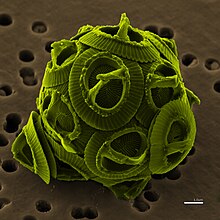
Summary
The cryptomonads-haptophytes assemblage is a proposed but disputed monophyletic grouping[1] of unicellular eukaryotes that are not included in the SAR supergroup. Several alternative names have been used for the group, including Hacrobia (derived from "ha-" referring to Haptophyta, "-cr-" referring to cryptomonads, and "-bia" as a general suffix referring to life);[2] CCTH (standing for Cryptophyta, Centrohelida, Telonemia and Haptophyta);[3] and "Eukaryomonadae".[4]
| Hacrobia | |
|---|---|

| |
| The coccolithophore Gephyrocapsa oceanica | |
| Scientific classification | |
| Domain: | Eukaryota |
| Clade: | Diaphoretickes |
| Kingdom: | Chromista |
| Subkingdom: | Hacrobia Okamoto et al., 2009 |
| Groups | |
| Synonyms | |
| |
As of February 2012[update], it is unclear whether this group is monophyletic or not; results of phylogenetic studies are "often dependent on the selection of taxa and gene data set".[3] Two 2012 studies produced opposite results.[3][5]
Members edit
In the past, heterokonts, haptophytes, and cryptomonads have sometimes been grouped together in a group known as chromists.[6] Though the heterokonts are now split out, Cryptophyta and Haptophyta are considered in some studies to be closely related[7][8] (and are sometimes simply referred to as the "Cryptophyta+Haptophyta" group).[9] A 2009 paper suggested that the Telonemia and centrohelids may form a clade with the cryptophytes and haptophytes.[10] The picobiliphytes may belong in this group but are too poorly known to be classified with confidence.[2]
Several recent studies have concluded that Haptophyta and Cryptophyta do not form a monophyletic group.[11] The former are a sister group to the SAR group, the latter cluster with the Archaeplastida (plants in the broad sense).[5] As of February 2012[update], it remains unclear whether the Hacrobia forms a monophyletic group.[3]
Another study[12] suggested the following arrangement: centrohelids are related to haptophytes and form the clade Haptista; Haptista is the sister group to SAR; Cryptista are related to Archaeplastida; and Haptista + SAR is the sister clade to Cryptista + Archaeplastida.
Phylogeny edit
Based on work done by Silar 2016.[13][14]
| Hacrobia |
| ||||||||||||||||||||||||||||||||||||||||||||||||
References edit
- ^ Sakaguchi M, Takishita K, Matsumoto T, Hashimoto T, Inagaki Y (July 2009). "Tracing back EFL gene evolution in the cryptomonads-haptophytes assemblage: separate origins of EFL genes in haptophytes, photosynthetic cryptomonads, and goniomonads". Gene. 441 (1–2): 126–31. doi:10.1016/j.gene.2008.05.010. PMID 18585873.
- ^ a b Okamoto, N.; Chantangsi, C.; Horák, A.; Leander, B.; Keeling, P.; Stajich, J. E. (2009). Stajich, Jason E. (ed.). "Molecular Phylogeny and Description of the Novel Katablepharid Roombia truncata gen. et sp. nov., and Establishment of the Hacrobia Taxon nov". PLOS ONE. 4 (9): e7080. Bibcode:2009PLoSO...4.7080O. doi:10.1371/journal.pone.0007080. PMC 2741603. PMID 19759916.
- ^ a b c d Zhao, Sen; Burki, Fabien; Bråte, Jon; Keeling, Patrick J.; Klaveness, Dag; Shalchian-Tabrizi, Kamran (2012). "Collodictyon—An Ancient Lineage in the Tree of Eukaryotes". Molecular Biology and Evolution. 29 (6): 1557–68. doi:10.1093/molbev/mss001. PMC 3351787. PMID 22319147.
- ^ "EUKARYOMONADAE". Retrieved 2015-03-01.
- ^ a b Burki, F.; Okamoto, N.; Pombert, J.F. & Keeling, P.J. (2012). "The evolutionary history of haptophytes and cryptophytes: phylogenomic evidence for separate origins". Proc. Biol. Sci. 279 (1736): 2246–54. doi:10.1098/rspb.2011.2301. PMC 3321700. PMID 22298847.
- ^ Csurös M, Rogozin IB, Koonin EV (May 2008). "Extremely intron-rich genes in the alveolate ancestors inferred with a flexible maximum-likelihood approach". Mol. Biol. Evol. 25 (5): 903–11. doi:10.1093/molbev/msn039. PMID 18296415.
- ^ Rice DW, Palmer JD (2006). "An exceptional horizontal gene transfer in plastids: gene replacement by a distant bacterial paralog and evidence that haptophyte and cryptophyte plastids are sisters". BMC Biol. 4: 31. doi:10.1186/1741-7007-4-31. PMC 1570145. PMID 16956407.
- ^ Aharon Oren; R. Thane Papke (1 July 2010). Molecular Phylogeny of Microorganisms. Horizon Scientific Press. pp. 190–. ISBN 978-1-904455-67-7. Retrieved 21 January 2011.
- ^ Reeb VC, Peglar MT, Yoon HS, et al. (May 2009). "Interrelationships of chromalveolates within a broadly sampled tree of photosynthetic protists". Mol. Phylogenet. Evol. 53 (1): 202–11. doi:10.1016/j.ympev.2009.04.012. PMID 19398025.
- ^ Burki, F; Inagaki, Y; Bråte, J; Archibald, J; Keeling, P; Cavalier-Smith, T; Sakaguchi, M; Hashimoto, T; Horak, A; Kumar, S; Klaveness, D; Jakobsen, KS; Pawlowski, J; Shalchian-Tabrizi, K (2009). "Large-scale phylogenomic analyses reveal that two enigmatic protist lineages, Telonemia and Centroheliozoa, are related to photosynthetic chromalveolates" (Free full text). Genome Biology and Evolution. 1: 231–8. doi:10.1093/gbe/evp022. PMC 2817417. PMID 20333193.
- ^ Baurain, Denis; Brinkmann, Henner; Petersen, Jörn; Rodríguez-Ezpeleta, Naiara; Stechmann, Alexandra; Demoulin, Vincent; Roger, Andrew J.; Burger, Gertraud; Lang, B. Franz & Philippe, Hervé (2010), "Phylogenomic Evidence for Separate Acquisition of Plastids in Cryptophytes, Haptophytes, and Stramenopiles", Molecular Biology and Evolution, 27 (7): 1698–1709, doi:10.1093/molbev/msq059, PMID 20194427
- ^ Burki, F; Kaplan, M; Tikhonenkov, DV; Zlatogursky, V; Minh, BQ; Radaykina, LV; Smirnov, A; Mylnikov, AP; Keeling, PJ (2016). "Untangling the early diversification of eukaryotes: a phylogenomic study of the evolutionary origins of Centrohelida, Haptophyta and Cryptista". Proc Biol Sci. 283 (1823): 20152802. doi:10.1098/rspb.2015.2802. PMC 4795036. PMID 26817772.
- ^ Silar, Philippe (2016), "Protistes Eucaryotes: Origine, Evolution et Biologie des Microbes Eucaryotes", HAL Archives-ouvertes: 1–462
- ^ Ruggiero; et al. (2015), "Higher Level Classification of All Living Organisms", PLOS ONE, 10 (4): e0119248, Bibcode:2015PLoSO..1019248R, doi:10.1371/journal.pone.0119248, PMC 4418965, PMID 25923521
- ^ Cavalier-Smith, T.; Chao, E. E.; Lewis, R. (17 April 2018), "Multigene phylogeny and cell evolution of chromist infrakingdom Rhizaria: contrasting cell organisation of sister phyla Cercozoa and Retaria", Protoplasma, 255 (5): 1517–1574, doi:10.1007/s00709-018-1241-1, PMC 6133090, PMID 29666938
External links edit
- Tree of Life: Hacrobia


